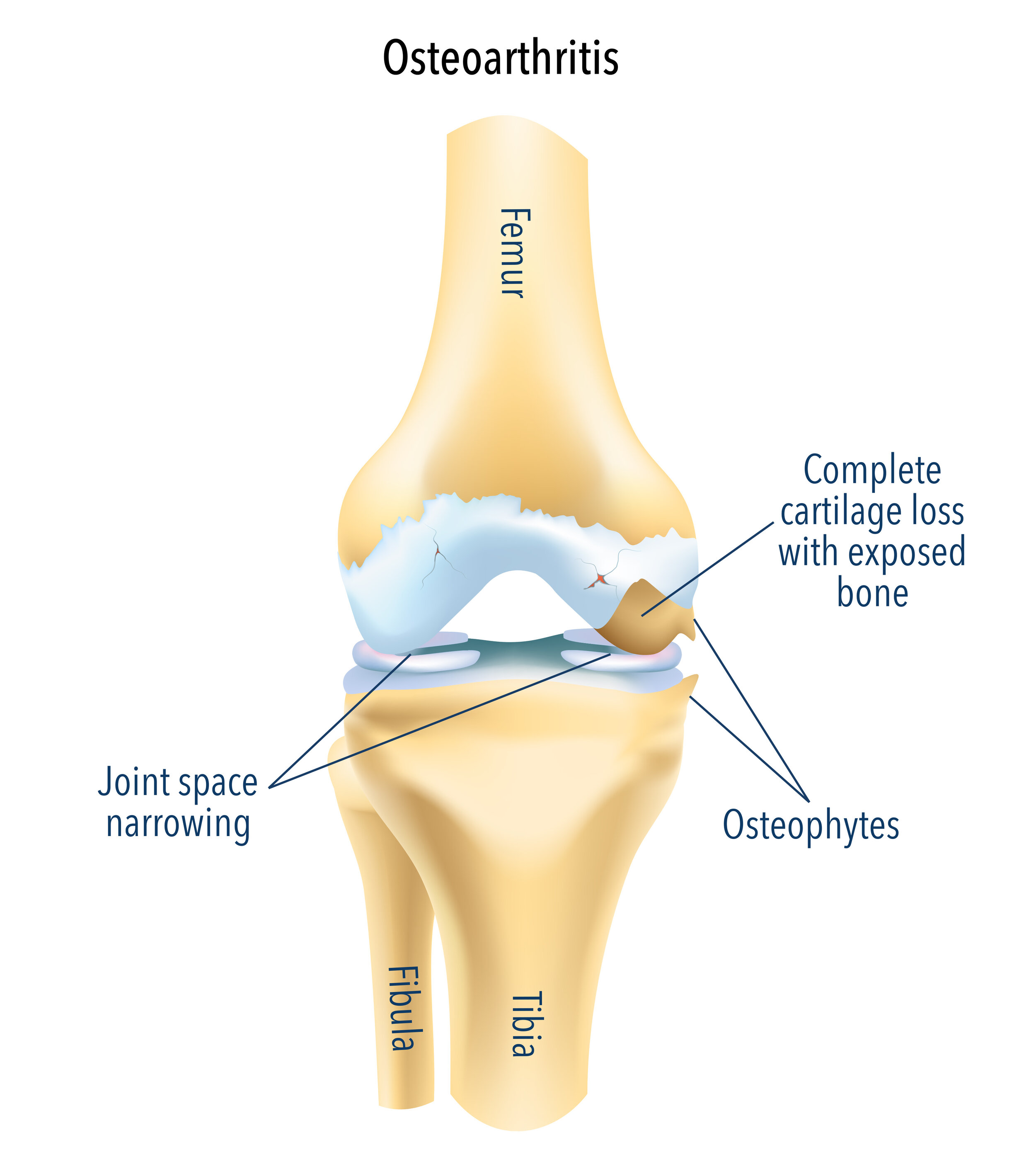Osteoarthritis
What is osteoarthritis?
Osteoarthritis is a result of cartilage loss within the knee and can cause knee pain.
The knee bends and straightens easily because it is covered in a smooth lining of tissue called cartilage. Cartilage is designed to absorb the shocks to your body during day-to-day activities such as walking. With age, the cartilage inside the joint can wear away and expose the underlying bone. Movement of the joint when the cartilage is completely worn can be painful as the bone rubs on bone.
What are the symptoms of osteoarthritis?
Patients typically present with pain in the affected joint. This may limit their walking distance and, in severe cases, affect their sleep at night. The pain may wax and wane in severity and may be associated with swelling within the knee.
Over time, the pain will cause the range of motion within the knee to decrease, and the knee will become stiff. This commonly presents as an inability to straighten the affected knee fully.
Sometimes, the alignment of the knee may change over time and may bow in or out (knock-knees).
How do you treat osteoarthritis?
Most patients with osteoarthritis can be managed without surgery. There are some simple measures that can help with the pain. Mr Pai will discuss non-operative options with you and ensure these are exhausted prior to offering an operative intervention.
There are a variety of non-surgical treatments available for osteoarthritis. Some are more effective than others. These include:
Weight loss
Physiotherapy
Hydrotherapy
Gait aids
Activity modification
Off-loading brace
Pain-relieving tablets
Paracetamol
Anti-inflammatory
Injections into the knee joint
Steroid
Hyaluronic acid
Platelet-rich plasma (PRP)
If these modalities fail and the pain persists, Mr Pai will talk to you about knee replacement surgery.
What does surgery for osteoarthritis involve?
If the decision is made to proceed with surgery, Mr Pai will recommend either a realignment osteotomy or knee replacement for you.
Realignment Osteotomy
Sometimes the alignment of your lower limbs can cause the weight of your body to be preferentially distributed to one side of the knee joint. If the arthritis affects that side of the knee joint, surgery can be performed to realign the bones of the lower limb so that the force is more evenly distributed to the knee joint. This is referred to as an osteotomy. Osteotomies are more likely to work if the arthritis is mild or moderate in severity.
The lower limb alignment is determined by clinical examination and by performing a special X-ray from the hip to the ankles. This will let us determine the angle of realignment required. The tibia or femur bone is then cut near the knee joint and realigned to the predetermined angle and held in this position using a metal plate and screws.
This operation does not cure the arthritis. It simply directs the force away from the area where the cartilage is worn. It can provide pain relief for several years and delay the need for a knee replacement. The advantage of this operation is that it preserves your own knee joint, and patients are usually able to return to more strenuous activities such as running and sport.
Knee Replacement Surgery
The knee joint can be anatomically divided into three components.
Medial component
Lateral component
Patellofemoral component
In a large proportion of patients, osteoarthritis only affects one of the three components. If this is the case, a partial knee replacement may be suitable. Some of the advantages include a smaller incision, smaller inpatient stay, and a faster recovery. Patients are more likely to return to certain sporting activities with a partial knee replacement compared to a total knee replacement.
If more than one part of the knee joint is affected by osteoarthritis, then a total knee replacement is more suitable.
How long is recovery following surgery for osteoarthritis?
Realignment Osteotomy
You will require an overnight stay in the hospital. The wounds take 2 weeks to heal. You will require crutches for 4-6 weeks after the operation. The bone that has been realigned takes 6-8 weeks to heal. On average, it will take 3 months before you can walk comfortably without gait aids. Returning to sport or heavy exercise will take 12 months.
Partial Knee Replacement
You will require a 2-3 day stay in the hospital. You will commence movement exercises and weight-bearing immediately after the operation. By 3 months post-operatively, most patients do not need strong painkillers and do not require gait aids.
Total Knee Replacement
You will require a 3-5 day stay in hospital. Most patients are discharged after their inpatient stay, but some may require inpatient rehabilitation. You will commence a range of motion exercises and weight-bearing immediately after the operation. Most patients do not need strong painkillers and do not require gait aids by 3 months post-operatively.

